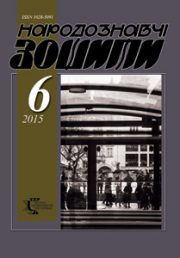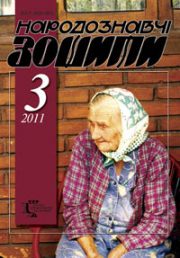The Ethnology Notebooks. 2021. # 1 (157), P. 169—182
УДК 7.071.1(477)(092)Черкасов В.”1929/2020″
DOI https://doi.org/10.15407/nz2021.01.170
Svitlana LUPIY
- Candidate of Art History, Professor,
- Lviv National Academy of Arts,
- Kubiyovycha Str., 38, Lviv,79011, Ukraine
- e-mail:
VOLODYMYR CHERKASOV. LIFE AND WORK IN THE CONTEXT OF TIME
Topicality. In contemporary Ukrainian art history, there is a growing interest in the work of artists of the second half of the twentieth and early twentieth centuries. In this discourse, the study of the work of the famous Lviv painter, Honored Artist of Ukraine Volodymyr Cherkasov (1929—2020) is relevant.
Purpose: to consider the life and creative path of the artist, to emphasize his importance as a teacher, as well as to analyze the works of the artist of different genres, to reveal the features of his figurative and artistic language.
Research methods are determined by the choice of topic. The methods accepted in art history are applied: art history analysis for revealing of features of creativity of the artist. A biographical-reconstructive method was also used to reveal the atmosphere in which the process of formation of the artist’s personality and creativity took place.
Results of the research. Peculiarities of V. Cherkasov’s artistic language were formed during his studies in Lviv and Kharkiv. He headed the departments of drawing, costume modeling, painting, taught painting and drawing in art studios in Lviv and Chervonohrad, and gained creative experience in scientific and creative trips to art universities in Kyiv, Riga, Kharkiv, Tallinn, Vilnius, St. Petersburg, Moscow, the Higher School of Printing in Leipzig, the Academy of Arts in Dresden, the Berlin School of Arts and Crafts, the Cyril and Methodius University in Veliko Tarnovo in Bulgaria. Created a number of paintings — a portrait landscapes, still lifes, which were exhibited at numerous exhibitions in Ukraine and abroad. The world of people, the world of nature in the works of V. Cherkasov is full of clarity and harmony. The figurative style of his paintings is balanced, without excessive compositional and color effects, because it is based on analytical and emotional study of nature. This is his creative credo. During the 1970’s and 1980’s, V. Cherkasov was a participant in traditional painting plein airs, and made «creative journeys» to the Carpathians, the Crimea, and the Baltics. The artist embodied his theoretical attitudes and artistic preferences in numerous paintings. V. Cherkasov’s works — paintings, graphics, watercolors — were exhibited at numerous exhibitions, group and individual. Practically all the artist’s creative work has been presented here since the 1960s. 2020. The artist’s works of different years — portraits, landscapes, still lifes, drawings were presented in his native walls — at an exhibition in the museum of the Lviv National Academy of Arts. Unfortunately, this was the last exhibition of the artist, who passed away in August 2020.
Conclusions. The peculiarities of V. Cherkasov’s work are considered, his understanding of the expressiveness of pictorial and plastic language is noted, which is vividly embodied in portraits, landscapes, still lifes, which capture the subtle sense of beauty of nature and man, bold play of colored planes.
Keywords: teacher, professor, portrait, landscape, still life, composition, colors.
REFERENCES
- Cherkasov, V. (2018). From the experience of my 50 years of creative and pedagogical work. Manuscript [in Ukrainian].
- Shcherbakova, O.O. (2008). Creative and pedagogical activity of M.S. Samokisha: from teaching to teaching. Visnyk Kharkivs’ka akademiya dyzaynu i mystetstv, 4 [in Ukrainian].
- Moleva, N., & Belyutin, E. (1958). School of Anton Azhbe. On the issue of ways of development of art pedagogy at the turn of the 19th—20th centuries. Moskva: Iskusstvo [in Russian].
- Golubets, O. (2001). Between freedom and totalitarianism. «Akademichnyy ekspres». Lviv [in Ukrainian].
- Zhinkin, N.I., & Gabrichevsky, A.G. (Ed.). (1927). Portrait forms. The art of portraiture. Sat. articles under. Moskva: Iskusstvo [in Russian].






